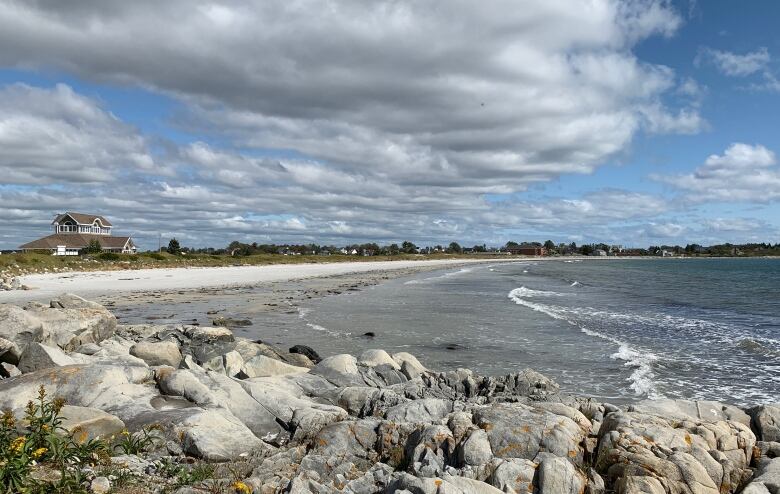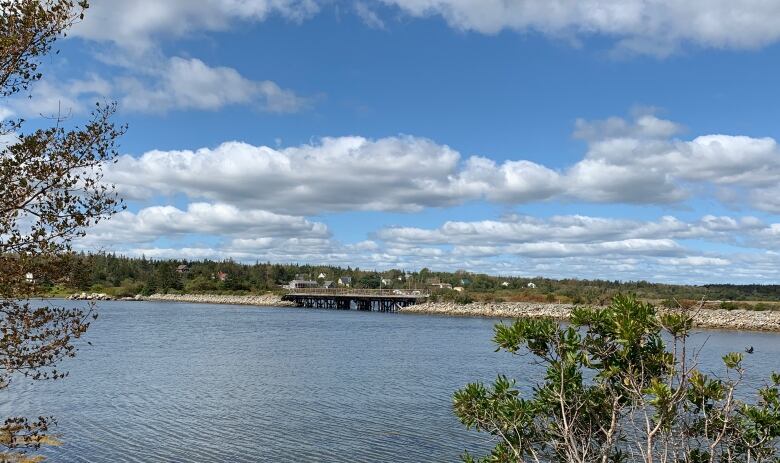Lockeport tries to address cost of climate change, but needs help
$1M design to redo causeway not possible without federal funds, says mayor

The realities of climate change play out almost literally at Fred Partridge's doorstep.
The Lockeport resident's historic family home, along with the rest of this tiny fishing community on Nova Scotia's south shore, has seen its share of storms.
But Partridge has noticed that those storms are more fierce and doing more damage as the sea level rises.
He recalls years ago when there was enough space on the water side of South Street across from his home for an 18-wheel truck to load up a dilapidated fishing boat pulled from the harbour.
Today, there's hardly enough room there for a small car.
Partridge has shored up the bank along the beach and roadside with large rocks to guard against erosion. It's something the town plans to replicate along the rest of the South Street shoreline, which leads to a wharf where fishing boats bring in their catches.
"I now have about half the land between the road and the beach, but it's secure," said Partridge.

Communities such as Lockeport are finding they must address climate change if their infrastructure and people are to remain safe. No piece of infrastructure is more vital to the community than the causeway that serves as the only road in and out of town.
For years, if the road bordering the sand dunes and picturesque Crescent Beach took a pounding from a storm, it would be from the beach side, said Mayor George Harding.
More recently, however, storm surge and rising tides are also approachingthe other side of the road from the town's back harbour.
"Previously, nobody worried about this other side," said Harding. "But now, with sea-level rise and storm surges, that is a critical thing."
Having participated in provincial and Atlantic studies on infrastructure and receivingassessments of vulnerabilities, Harding said it was clear the town had to do something.

Council commissioned an engineering design study that calls for a realignment of the road where it crosses the back harbour so it would now enter town behind the school sports field.
It would also be raised, so cars would actually be able to see over the sand dunes. The existing part of the roadway would remain, but no longer be used to get in and out of town.
The cost of that work is pegged at a little more than $1 million. While that might not be a lot of money for some municipalities, for the town of 531 people it represents the value of an entire year's budget.
"For us to do it, we really have to rely on government funding," said Harding.
While infrastructure projects are typically funded evenly by all three levels of government, Harding said Lockeport was pinning its hopes on a promised federal program where Ottawa and the province would cover 93 per cent of a project's cost for communities with fewer than 5,000 people.
"That makes it really manageable for us," he said.
"We wouldn't be able to afford one-third of our budget [for a single project]."

Unfortunately for Lockeport, the program hasn't taken applications. Harding said they hope something can happen after next month's federal election.
In the meantime, the town is finishing up a $100,000 project torestorethe trestle trail bridge. When it's finished,the bridge will serve as both a walking trail for residents and breakwater in the back harbour to helpprotect the causeway.
The costs might be high for the town, but Harding said the cost of doing nothing would eventually be even higher.
Provincial government stats show the town's fishery brought in 770,000 kilograms of fish with a value of $12.7 million in 2017.
That's not counting the business that takes place at the R. Baker Fisheries and Clearwater fish plants, sources of employment for the town as well as people in other parts of Shelburne County and Queens County jobs and product that rely on the causeway being secure.
"You can turn a blind eye if you're ignorant of some of the facts," Harding said of climate change.
"But when the facts are staring you right in the face you just can't ignore them. You have to start acting on them."
MORE TOP STORIES












_(720p).jpg)


 OFFICIAL HD MUSIC VIDEO.jpg)
.jpg)



























































































